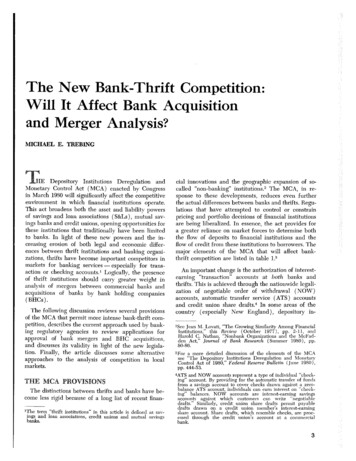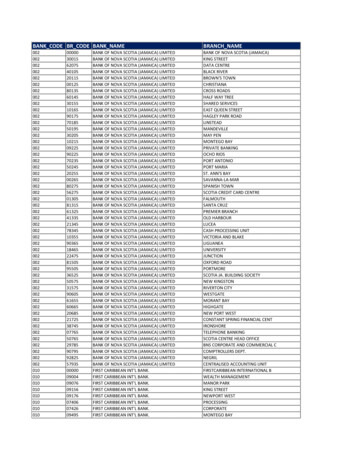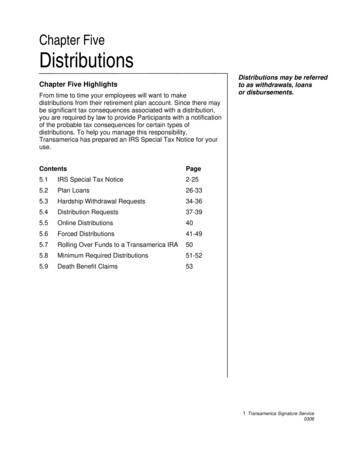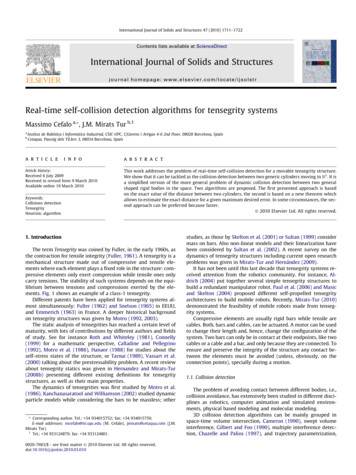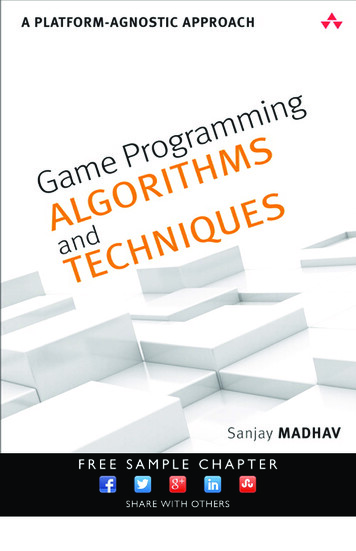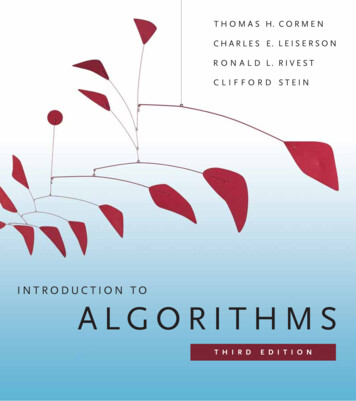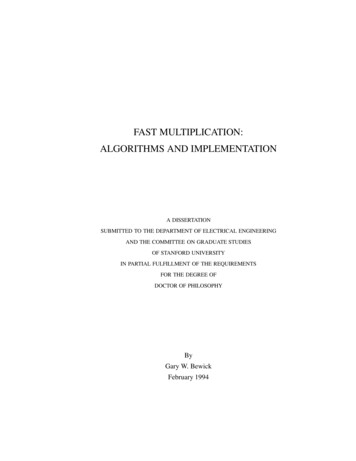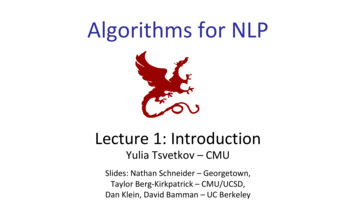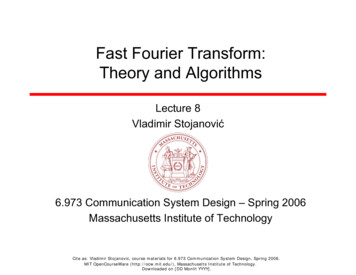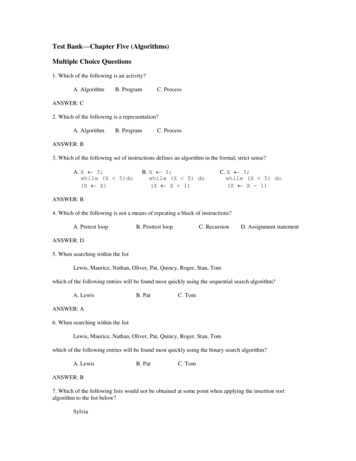
Transcription
Test Bank—Chapter Five (Algorithms)Multiple Choice Questions1. Which of the following is an activity?A. AlgorithmB. ProgramC. ProcessANSWER: C2. Which of the following is a representation?A. AlgorithmB. ProgramC. ProcessANSWER: B3. Which of the following set of instructions defines an algorithm in the formal, strict sense?A. X 3;while (X 5)do(X X)B. X 3;while (X 5) do(X X 1)C. X 3;while (X 5) do(X X - 1)ANSWER: B4. Which of the following is not a means of repeating a block of instructions?A. Pretest loopB. Posttest loopC. RecursionD. Assignment statementANSWER: D5. When searching within the listLewis, Maurice, Nathan, Oliver, Pat, Quincy, Roger, Stan, Tomwhich of the following entries will be found most quickly using the sequential search algorithm?A. LewisB. PatC. TomANSWER: A6. When searching within the listLewis, Maurice, Nathan, Oliver, Pat, Quincy, Roger, Stan, Tomwhich of the following entries will be found most quickly using the binary search algorithm?A. LewisB. PatC. TomANSWER: B7. Which of the following lists would not be obtained at some point when applying the insertion sortalgorithm to the list below?Sylvia
NancyLoisAliceA. NancySylviaLoisAliceB. AliceLoisNancySylviaC. AliceSylviaNancyLoisD. LoisNancySylviaAliceANSWER: C8. In general, an algorithm in which of the following categories is considered more efficient?A. (lg n)B. (n)C. (n lg n)D. ( n2 )ANSWER: B9. The insertion sort algorithm is an example of an algorithm in which of the following classes?A. (lg n)B. (n)C. (n lg n)D. ( n2 )ANSWER: D10. The binary search algorithm is an example of an algorithm in which of the following classes?A. (lg n)B. (n)C. (n lg n)D. ( n2 )ANSWER: A11. Under the assumption that X takes on only integer values, which of the following is the terminationcondition for the following loop?while (X 5) do( . . . )A. X 5 B. X 4C. X 4ANSWER: B12. Under the assumption that X takes on only integer values, which of the following is the terminationcondition for the following loop?repeat ( . . . )until (X 5)A. X 5 B. X 4C. X 5ANSWER: A13. Under the assumption that N takes on only integer values, which of the following is the terminationcondition in the following recursive procedure?procedure xxx (N)if (N 5) then (apply the procedure xxx to the value N 1)else (print the value of N)
A. N 5 B. N 4C. N 4ANSWER: B14. Under the assumption that N takes on only integer values, which of the following is the terminationcondition in the following recursive procedure?procedure xxx (N)if (N 5) then (print the value of N)else (apply the procedure xxx to the value N - 1)A. N 5 B. N 4C. N 5ANSWER: A15. Which of the following is a loop invariant at the point at which the test for termination is performed inthe following loop structure?X 3;while (X 5) do(X X 2)A. X 5 B. X 5C. X 5D. X 5ANSWER: D16. Which of the following is a loop invariant at the point at which the test for termination is performed inthe following loop structure?X 3;repeat (X X 2)until (X 5)A. X 5 B. X 8C. X 5D. X 6ANSWER: B17. Which of the following is the base case in the recursive procedure below?procedure xxx (N)if (N 0) then (print the value of N)else (apply the procedure xxx to the value N - 1)A. N 0 B. N 0C. N 0ANSWER: B18. Preconditions, postconditions, and loop invariants are examples of which of the following?A. PseudocodeB. Iterative structuresC. AssertionsD. RecursionANSWER: C19. Which of the following does not print the same sequence of numbers as the others?
A. X 5while (X 6) do(print the value of X;of X;X X 1)B. X 4while (X 5) do(X X 1;C. X 5repeat(print the valueX X 1)until (X 6)print the value of X)ANSWER: C20. Which of the following is not a way of representing algorithms?A. Stepwise refinementB. PseudocodeC. FlowchartD. Programming languageANSWER: AFill-in-the-blank/Short-answer Questions1. Define each of the following terms.A. AlgorithmB. ProgramC. ProcessANSWER: A. An ordered collection of unambiguous, executable steps that defines a terminating processB. A representation of an algorithm (perhaps nonterminating algorithm)C. The action of executing a program (or algorithm)2. List three of the primitives in the pseudocode developed in this chapter.ANSWER: Possible answers include: the assignment statement using , the if-then-else statement, thewhile statement, the repeat statement, and the definition and activation of procedures.3. What sequence of values will be printed when the following instructions are executed?X 5;if (X 7) then (print theY 6)else (print theY 4)if (Y 5) then (print theelse (print thevalue 6;value 4;value 3)value 2)
ANSWER: 6, 24. What sequence of values will be printed when the following instructions are executed?X 5;while (X 7) do(print the value of X;X X 1)print the value of X;while (X 2) do(print the value of X;X X - 2)ANSWER: 5, 6, 7, 7, 5, 35. What sequence of values would be printed if the procedure xxx described below were executed with thevalue of N being 9?procedure xxx (N)if (N 4) then (printapplyelse (applyprintthethethethevalue of N;procedure yyy to the value 7)procedure yyy to the value 2;value of N)procedure yyy (N)if (N 5) then (print the value of N;apply the procedure zzz to the value 6)else (apply the procedure zzz to the value 5)procedure zzz (N)if (N 5) then (print the value 7)else (print the value 8)ANSWER: 2, 8, 96. When searching for the entry X within the listR, S, T, U, V, W, Zhow many entries will be considered before discovering that the entry is not present? (Note that the list is inalphabetical order.)ANSWER: 37. When searching for the entry X within the listR, S, T, U, V, W, Z
how many entries will be considered before discovering that the entry is not present? (Note that the list is inalphabetical order.)ANSWER: 78. Suppose the binary search algorithm was being used to search for the entry Tom in the listNathan, Oliver, Pat, Quincy, Rodger, Stan, TomA. What would be the first entry in the list to be considered?B. What would be the second entry in the list to be considered?ANSWER: A. QuincyB. Stan9. At most, how many entries in a list of 5000 names will be interrogated when using the binary searchalgorithm?ANSWER: 1310. At most, how many entries in a list of 5000 names will be interrogated when using the sequential searchalgorithm?ANSWER: 500011. Which of the sequential or binary search algorithms would find the name Kelly in the listJohn, Kelly, Lewis, Maurice, Nathan, Oliver, Pat, Quincy, Roger, Stan, Tommore quickly?ANSWER: Sequential12. Which of the sequential or binary search algorithms would find the name Roger in the listJohn, Kelly, Lewis, Maurice, Nathan, Oliver, Pat, Quincy, Roger, Stan, Tommore quickly?ANSWER: Binary13. What would be printed if the following instructions were executed?X 3;print the value of X;
Y 5;if (X Y) then (print the value 6)else (print the value 7)ANSWER: 3, 614. What would be printed if the following instructions were executed?X 3;while (X 0) do(print the value of X;X X - 1)ANSWER: 3, 2, 115. Answer the following questions in terms of the procedure xxx below.procedure xxx (N)if (N 7) then (print the value of N)else (add 3 to the value of N andprint the value of N)A. What value would be printed if the following procedure were executed with the value of Nbeing 4?B. What value would be printed if the following procedure were executed with the value of Nbeing 9?ANSWER: A. 4B. 1216. What sequence of numbers would be printed if the following procedure were executed with the value ofN being 0?procedure xxx (N)while (N 4) do(print the value of N;N N 2;print the value of N)ANSWER: 0, 2, 2, 417. What sequence of numbers would be printed if the following procedure were executed with the value ofN being 0?procedure xxx (N)
print the value of N;if (N 5) then (apply the procedure xxx to the value N 2);print the value of NANSWER: 0, 2, 4, 6, 6, 4, 2, 018. What sequence of numbers would be printed if the following procedure were executed with the value ofN being 0?procedure xxx (N)print the value of N;if (N 2) then (apply the procedure xxx to the value N 1)else (print the value of N)print the value of NANSWER: 0, 1, 2, 2, 2, 1, 019. What sequence of numbers would be printed if the procedure named xxx as described below wereexecuted with the value of N being 2?procedure xxx (N)print the value of N;if (N 3)then (apply procedure yyyto the value 4);print the value of Nprocedureprint theapply theprint theyyy (N)value of N;procedure xxx to the value 5;value of NANSWER: 2, 4, 5, 4, 220. Circle the portion of the program below in which control of the loop is initialized. Draw a rectanglearound the portion in which the test for termination is performed. Underline the portion in which the state ofthe loop is moved toward the termination condition.X 3;while (X 9) do(X X 1)ANSWER: Circle: X 3, Rectangle: while (X 9), Underline: X X 121. Fill in the blank in the procedure below so that the procedure prints the integers from 0 up to the integervalue it was given for N. That is, if the procedure is executed with the value of N being 3, it should print 0,1, 2, 3.procedure xxx (N)if ( ) then (apply the procedure xxx to the value N - 1);print the value of N)ANSWER: N 022. Identify a loop invariant associated with the point in the loop below at which a test for termination isperformed.
X 0;repeat (print the value of X;X X 2)until (X 6)ANSWER: Possible answers include: X 0, X 9, X is an even integer, and othersVocabulary (Matching) QuestionsThe following is a list of terms from the chapter along with descriptive phrases that can be used to producequestions (depending on the topics covered in your course) in which the students are ask to match phrasesand terms. An example would be a question of the form, “In the blank next to each phrase, write the termfrom the following list that is best described by the phrase.”TermDescriptive Phrasealgorithmpseudocodeassignment statementif-then-else statementstepwise refinementloop invariantThe fundamental concept in computer scienceAn informal notation for representing algorithmsA means of saving the result of a computation for future useA means of producing different actions depending on a conditionA divide and conquer approach to problem solvingA statement that is true each time a specific point in a repetitiveprocess is reachedA program segment isolated as a unitThe technique of applying a program segment within itselfLooks before it leapsA formal means of verifying softwareLess efficient than the binary methodA basic building blockprocedurerecursionpretest loopproof of correctnesssequential searchprimitiveGeneral Format Questions1. Rewrite the following routine using a prettest while statement.repeat (print the value of X;X X 1)until (X 5)ANSWER: One possible solution is:print the value of X;X X 1;while (X 5) do(print the value of X;X X 1)
2. If numeric values are represented in two’s complement notation, does the following program represent aninfinite process? Explain your answer.X 2while (X 0) do(X X 1)ANSWER: (CAUTION: This problem relies on material from Chapter 1.) No, the process will terminatebecause X will become negative due to overflow.3. Identify a flaw in the control of the following loop.X 3while (X 8) do(X X 2)ANSWER: The termination condition will never be reached because X will always be odd.4. Do the following instructions define an algorithm? Explain your answer.Write down all the positive odd integers.Select the integer in the middle of the list.Print the even integer that is one less than the selected odd integer.ANSWER: No, the instructions are not executable (not effective).5. Use a repeat loop structure to produce a non-recursive program segment that prints the same sequence ofnumbers as the following recursive procedure.procedure xxx (N)print the value of N:if (N 5) then (apply the procedure xxx to the value N 1)ANSWER: repeat (print the value of N;N N 1)until (N 6)6. Use a while loop structure to produce a non-recursive program segment that prints the same sequence ofnumbers as the following recursive procedure.procedure xxx (N)print the value of N:if (N 5) then (apply the procedure xxx to the value N 1)ANSWER: print the value of N;while (N 6) do(print the value of N;N N 1)7. Use a repeat loop rather than a while loop to accomplish the same results as the following programsegment. Assume that X will have only integer values. (You may also use an if statement if you like.)while (X 5) do(print the value of X;X X 1)
ANSWER: if (X 5) then (repeat (print the value of X;X X 1)until (X 5))8. Suppose the statement “X is an integer and X 5” is a loop invariant at the point at which the test fortermination is performed in the loop outlined below. What can be concluded about the value of Ximmediately after the loop is terminated?repeat ( . . . )until (X 3)ANSWER: X 49. The pseudocode used in this chapter included both an if-then statement and an if-then-else statement.Show how the statementif (X 5) then ( . . . )else ( . . . )can be simulated with a program segment using only if-then statements.ANSWER: First pick a variable that does not already appear in the program. Call it Y. Then the followingis a solution:Y Xif (Y 5) then ( . . . )if (Y 5) then ( . . . )(Note that “if (X 5) then ( ); if (X 5) then ( )” is not correct since the first thenclause may change the value of X.)10. The following procedure was designed to compute the largest integer whose square is no greater than N,where N is assumed to be a positive number. (If N is 5, then the procedure should report the value 2.) Findand correct the error.procedure squareroot (N)X 0;while (X2 N) do(X X 1);report the value of XANSWER: The value reported should be X - 1. p
Test Bank —Chapter Five . Lewis, Maurice, Nathan, Oliver, Pat, Quincy, Roger, Stan, Tom which of the following entries will be found most quickly using the binary search algorithm? A. Lewis B. Pat C. Tom ANSWER: B 7. Which of the following lists would not be obtained at some point when applying the insertion sort algorithm to the list below? Sylvia . Nancy Lois Alice A. Nancy B. Alice C .


